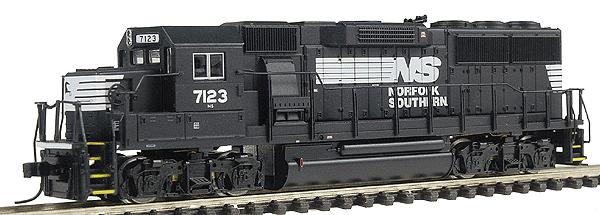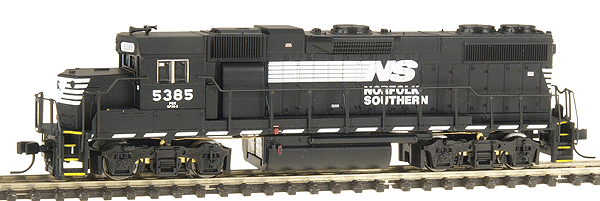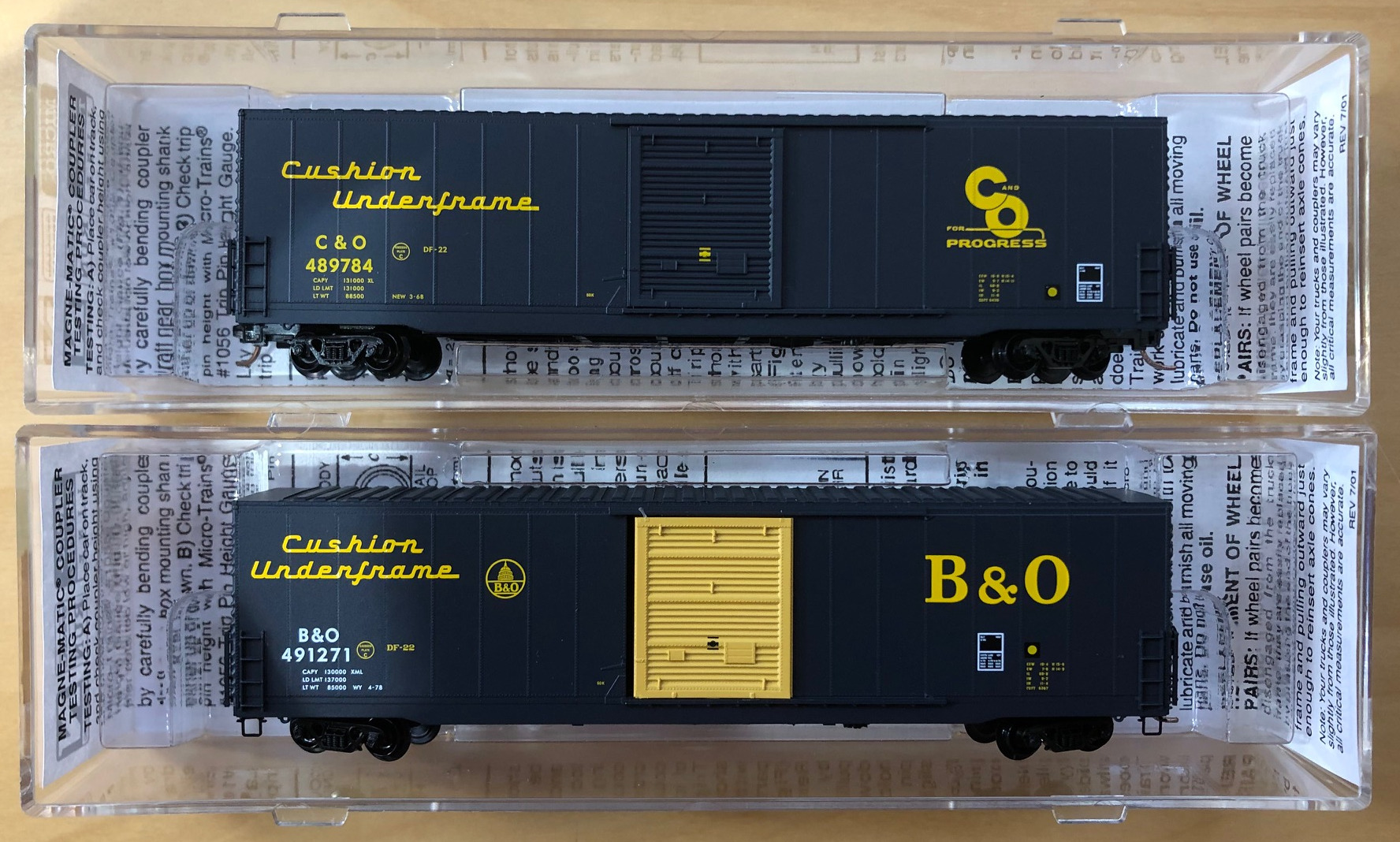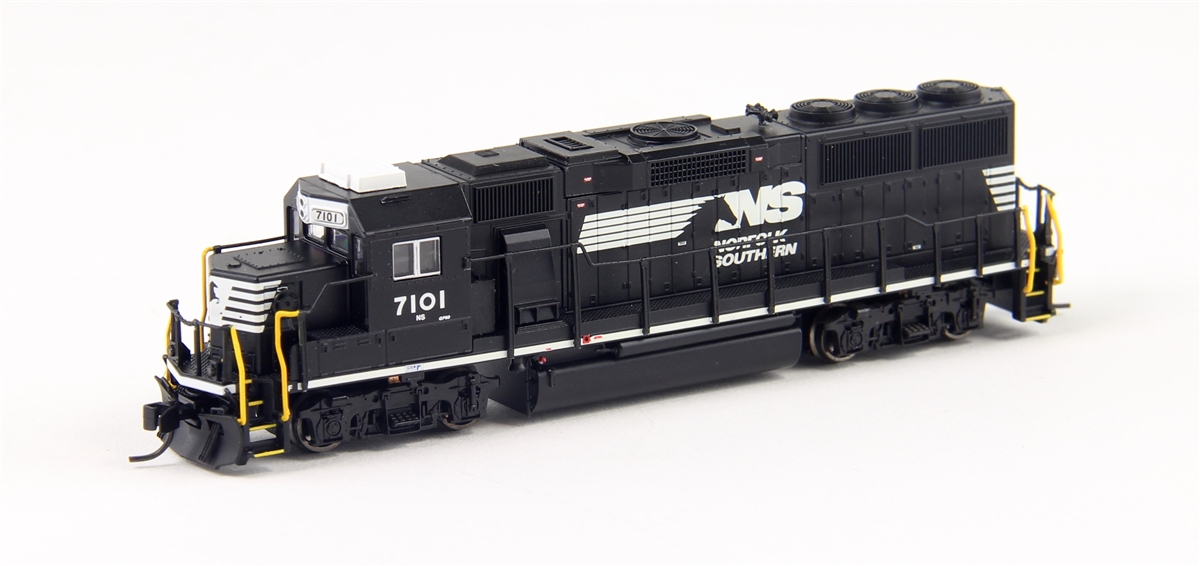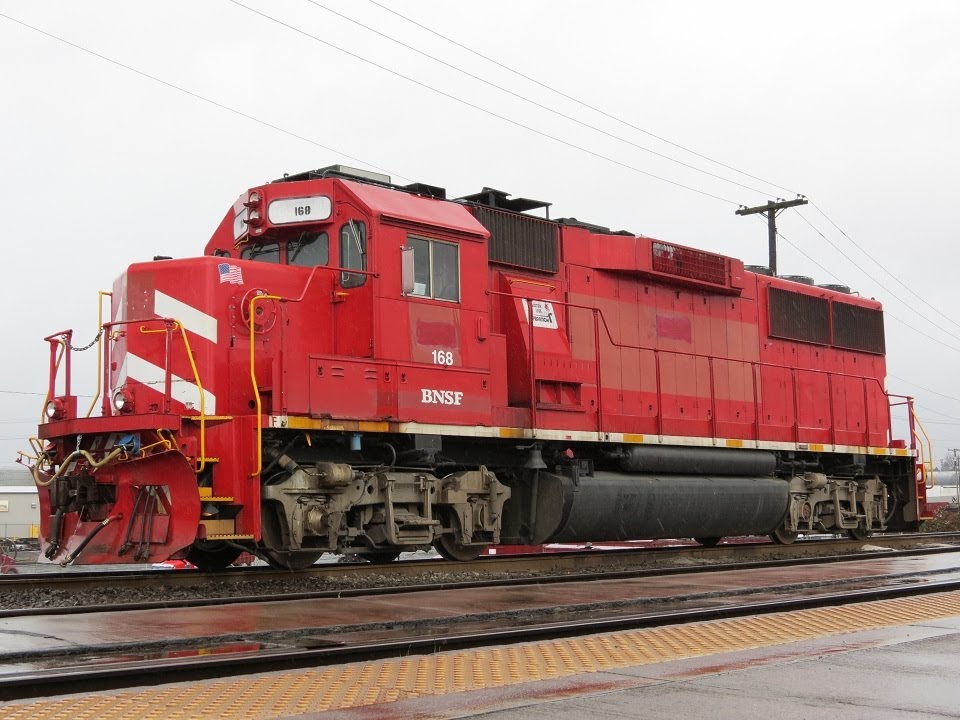Model Information: Life-Like introduced this model in 2004. The original version had no DCC capability. A new mechanism was swapped in in 2012 with appropriate DCC readiness. The detailing is quite nice and the performance is excellent in terms of quietness, smoothness, low-speed operation and pulling.
DCC Information: Anything designed for Life-Like's DCC-Ready GP20 will work (IE a Digitrax DN163L0A or a TCS L1D4).
Prototype History: An EMD GP60 is a 4-axle (B-B) diesel-electric locomotive built by General Motors Electro-Motive Division between 1985 and 1994. The GP60 was EMD's first engine that was classified as a "third-generation" locomotive. Hidden behind the electrical cabinet doors on the rear wall of the cab, the GP60 concealed a trio of microprocessors that monitored and managed a host of engine, cooling system and control functions. The engine's on-board microprocessors replaced hundreds of wiring circuits, dozens of relays and all but one module card, making it an improvement among EMD's engines.
Power was provided by a 16-cylinder 710G3A diesel engine, which could produce 3,800 horsepower (2,800 kW). This locomotive was 59 feet 9 inches long and featured a 3,700-US-gallon (14,000 L) fuel tank. The GP60 series shared the same frame as the GP59. Cabless 'B' units of this locomotive model were also built; they were known as GP60B models, purchased exclusively by the Atchison, Topeka and Santa Fe Railway. Units built with a wide/comfort/safety cab and a wide nose were designated GP60M and all purchased by the Santa Fe. A total of 294 GP60, 23 GP60B and 63 GP60M units were built by EMD. Due to the mainstream focus of railroads on powerful six-axle units, and strict emissions standards, the GP60 will most likely be the last new EMD "Geep".
From Wikipedia
Power was provided by a 16-cylinder 710G3A diesel engine, which could produce 3,800 horsepower (2,800 kW). This locomotive was 59 feet 9 inches long and featured a 3,700-US-gallon (14,000 L) fuel tank. The GP60 series shared the same frame as the GP59. Cabless 'B' units of this locomotive model were also built; they were known as GP60B models, purchased exclusively by the Atchison, Topeka and Santa Fe Railway. Units built with a wide/comfort/safety cab and a wide nose were designated GP60M and all purchased by the Santa Fe. A total of 294 GP60, 23 GP60B and 63 GP60M units were built by EMD. Due to the mainstream focus of railroads on powerful six-axle units, and strict emissions standards, the GP60 will most likely be the last new EMD "Geep".
From Wikipedia
Road Name History: The Norfolk Southern Railway (reporting mark NS) is a Class I railroad in the United States; began in 1982 and 1990. With headquarters in Norfolk, Virginia, the company operates 36,200 route miles in 22 eastern states, the District of Columbia, and has rights in Canada from Buffalo to Toronto and over the Albany to Montreal route. NS is responsible for maintaining 29,000 miles, with the remainder being operated under trackage rights from other parties responsible for maintenance. The common commodity hauled on the railroad is coal from mines in Indiana, Kentucky, Pennsylvania, Tennessee, Virginia, and West Virginia. The railroad also offers the most intermodal network in eastern North America.
NS is a major transporter of domestic and export coal. The railroad's major sources of the mineral are located in: Pennsylvania's Cambria and Indiana counties, as well as the Monongahela Valley; West Virginia; and the Appalachia regions of Virginia, Kentucky, and Tennessee. In Pennsylvania, NS also receives coal through interchange with R.J. Corman Railroad/Pennsylvania Lines at Cresson, Pennsylvania, originating in the "Clearfield Cluster". NS's export of West Virginia bituminous coal, begins transport on portions of the well-engineered former Virginian Railway and the former N&W double-tracked line in Eastern Virginia to its Lambert's Point coal pier on Hampton Roads at Norfolk. Coal transported by NS is thus exported to steel mills and power plants around the world. The company is also a major transporter of auto parts and completed vehicles. It operates intermodal container and TOFC (trailer on flat car) trains, some in conjunction with other railroads. NS was the first railway to employ roadrailers, which are highway truck trailers with interchangeable wheel sets.
The Norfolk Southern Railway's parent Norfolk Southern Corporation is a Norfolk, Virginia-based parent company. Norfolk Southern Corporation was incorporated on July 23, 1980 in the Commonwealth of Virginia and is publicly traded on the New York Stock Exchange (NYSE) under the symbols NSC. The primary business function of Norfolk Southern Corporation is the rail transportation of raw materials, intermediate products, and finished goods across the Southeast, East, and Midwest United States. The corporation further facilitates transport to the remainder of the United States through interchange with other rail carriers while also serving overseas transport needs by serving several Atlantic and Gulf Coast ports. As of October 1, 2014 Norfolk Southern Corporation's total public stock value was slightly over $34.5 billion.
Read more on Wikipedia.
NS is a major transporter of domestic and export coal. The railroad's major sources of the mineral are located in: Pennsylvania's Cambria and Indiana counties, as well as the Monongahela Valley; West Virginia; and the Appalachia regions of Virginia, Kentucky, and Tennessee. In Pennsylvania, NS also receives coal through interchange with R.J. Corman Railroad/Pennsylvania Lines at Cresson, Pennsylvania, originating in the "Clearfield Cluster". NS's export of West Virginia bituminous coal, begins transport on portions of the well-engineered former Virginian Railway and the former N&W double-tracked line in Eastern Virginia to its Lambert's Point coal pier on Hampton Roads at Norfolk. Coal transported by NS is thus exported to steel mills and power plants around the world. The company is also a major transporter of auto parts and completed vehicles. It operates intermodal container and TOFC (trailer on flat car) trains, some in conjunction with other railroads. NS was the first railway to employ roadrailers, which are highway truck trailers with interchangeable wheel sets.
The Norfolk Southern Railway's parent Norfolk Southern Corporation is a Norfolk, Virginia-based parent company. Norfolk Southern Corporation was incorporated on July 23, 1980 in the Commonwealth of Virginia and is publicly traded on the New York Stock Exchange (NYSE) under the symbols NSC. The primary business function of Norfolk Southern Corporation is the rail transportation of raw materials, intermediate products, and finished goods across the Southeast, East, and Midwest United States. The corporation further facilitates transport to the remainder of the United States through interchange with other rail carriers while also serving overseas transport needs by serving several Atlantic and Gulf Coast ports. As of October 1, 2014 Norfolk Southern Corporation's total public stock value was slightly over $34.5 billion.
Read more on Wikipedia.
Brand/Importer Information:  Life-Like Products LLC (now Life-Like Toy and Hobby division of Wm. K. Walthers) was a manufacturer of model railroad products and was based in Baltimore, Maryland.
Life-Like Products LLC (now Life-Like Toy and Hobby division of Wm. K. Walthers) was a manufacturer of model railroad products and was based in Baltimore, Maryland.
It was founded in the 1950s by a company that pioneered extruded foam ice chests under the Lifoam trademark. Because ice chests are a summer seasonal item, the company needed a way to keep the factory operating year round. As model railroading was becoming popular in the post-war years, they saw this as an opportunity and so manufactured extruded foam tunnels for model trains. Over the years, Life-Like expanded into other scenery items, finally manufacturing rolling stock beginning in the late 1960s. At some point in the early 1970s, Life-Like purchased Varney Inc. and began to produce the former Varney line as its own.
The Canadian distributor for Life-Like products, Canadian Hobbycraft, saw a missing segment in market for Canadian model prototypes, and started producing a few Canadian models that were later, with a few modifications, offered in the US market with US roadnames.
In 2005, the company, now known as Lifoam Industries, LLC, decided to concentrate on their core products of extruded foam and sold their model railroad operations to Wm. K. Walthers.
In June 2018, Atlas and Walthers announced to have reached an agreement under which all Walthers N scale rolling stock tooling, including the former Life-Like tooling, will be purchased by Atlas.
Read more on Wikipedia and The Train Collectors Association.

It was founded in the 1950s by a company that pioneered extruded foam ice chests under the Lifoam trademark. Because ice chests are a summer seasonal item, the company needed a way to keep the factory operating year round. As model railroading was becoming popular in the post-war years, they saw this as an opportunity and so manufactured extruded foam tunnels for model trains. Over the years, Life-Like expanded into other scenery items, finally manufacturing rolling stock beginning in the late 1960s. At some point in the early 1970s, Life-Like purchased Varney Inc. and began to produce the former Varney line as its own.
The Canadian distributor for Life-Like products, Canadian Hobbycraft, saw a missing segment in market for Canadian model prototypes, and started producing a few Canadian models that were later, with a few modifications, offered in the US market with US roadnames.
In 2005, the company, now known as Lifoam Industries, LLC, decided to concentrate on their core products of extruded foam and sold their model railroad operations to Wm. K. Walthers.
In June 2018, Atlas and Walthers announced to have reached an agreement under which all Walthers N scale rolling stock tooling, including the former Life-Like tooling, will be purchased by Atlas.
Read more on Wikipedia and The Train Collectors Association.
Item created by: gdm on 2017-01-11 07:36:18
If you see errors or missing data in this entry, please feel free to log in and edit it. Anyone with a Gmail account can log in instantly.
If you see errors or missing data in this entry, please feel free to log in and edit it. Anyone with a Gmail account can log in instantly.


